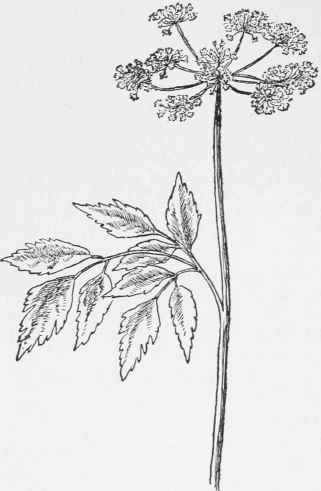Golden Meadow-Parsnip. Golden Meadow-Parsnip. Early Meadow-Parsnip. Zizia Aurea
Description
This section is from the book "Our Early Wild Flowers", by Harriet Louise Keeler. See also: Newcomb's Wildflower Guide.
Golden Meadow-Parsnip. Golden Meadow-Parsnip. Early Meadow-Parsnip. Zizia Aurea
Zizia, in honor of Ziz, a Rhenish botanist.
Perennial. In fields, meadows, and swamps. New Brunswick to Florida, west to Dakotas and Texas. Common in northern Ohio. April-June.
Stem
Smooth, one to three feet high, hollow, green with brownish tinge.
Leaves
Basal leaves long-petioled, compound in twos or threes; leaflets ovate to lanceolate, sharply serrate; upper leaves with sheathing petioles; leaflets twice or thrice-parted.
Flowers
Brilliant yellow, in compound umbels two to three inches across; no involucre; involucels of small bracts; each tiny floret has five small petals; the shape of the little umbels is globular rather than flat; fifteen to twenty rays in each.
Involucre
Wanting; involucels of the small umbels of several small bracts.
Calyx
Adherent to ovary, five-toothed.
Corolla
Petals five, bright yellow, incurved both in bud and in bloom.
Stamens
Five.
Pistil
Of two carpels; styles two.
Fruit
Dry, ovoid; ribs usually winged.
The golden-yellow clusters of the Early Meadow-Parsnip often get into the race in April and are especially noticeable because of the pure brilliant yellow of the massed florets. The inflorescence is a compound umbel, that is, the flower-stems of each little cluster of florets arise from the same point; there are usually eight to ten of these flower-stems each bearing an umbel called an umbellet. These umbellets are usually half an inch across and number about twenty

Golden Meadow-Parsnip.
Zizia aurea florets, which are yellow; calyx, corolla, tiny filaments, and minute anther all yellow, and the effect is glowing. The shape of the umbel varies from a half-hemisphere to globular. At the point where the flower-stems arise there is usually, in umbelliferous plants, a group of green bracts called the involucre. In the MeadowParsnip these are wanting. At the point where the tiny stems of the umbellets arise there are a few minute bracts, which form an involucel; these are present in the Meadow-Parsnip, but very small.
The stem is two to three feet high, hollow, and strong. The stem-leaves have sheathing petioles. All the leaves are twice or thrice-compound of oblong or ovate leaflets that are deeply serrate; sometimes the lateral leaflets are once-cleft.
The petals of the corolla are curiously incurved, apparently the aim being to keep the stamens in hiding until the pistil is mature and pollinated.
Continue to:


